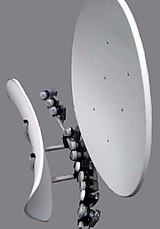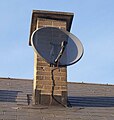Types

Motor-driven dishedit
A dish that is mounted on a pole and driven by a stepper motor or a servo can be controlled and rotated to face any satellite position in the sky. There are three competing standards: DiSEqC, USALS, and 36 V positioners. Many receivers support all of these standards.
Motor-driven dishes are popular with enthusiasts. Although there is no problem with equipment pricing, only price for space required for installation. And making the installation wind proof for big size dish. Even standard or small size dishes can be used, however enthusiasts tend to prefer the largest possible sizes (at least 120cm) in order to receive signals from remote weak satellite positions. The cheapest sizes for Ku band are up to 120cm. Sizes above 120cm have rapid sharp price increase in comparison to ordinary commercial application for end consumer (ordinary viewer). Although pricing is different for countries where there is no freedom for Ku band, and end consumer (ordinary viewer) is only allowed to receive channels from C band, which require in most cases sizes 150cm and above.
What needs to be noted DiSEqC or USALS allows to switch automatically between 16 satellite positions as user changes channel on remote control.
What is more, mounting dish with USALS motor requires just to find and precisely aim at 1st position, all the other satellites positions are found and aimed automatically. And if position are close it can be done within seconds.
Most of receiver sold nowadays are compatible with USALS and DiSEqC 1.0 and 1.2, DiSEqC 1.1 is least popular.
Multi-satelliteedit
Every standard size dish enables simultaneous reception from multiple different satellite positions without re-positioning the dish, just by adding additional LNB or using Special Duo LNB or Triple or Four Feed Monoblock LNB. However some designs much more effectively optimize simultaneous reception from multiple different satellite positions without re-positioning the dish. The vertical axis operates as an off-axis concave parabolic concave hyperbolic Cassegrain reflector, while the horizontal axis operates as a concave convex Cassegrain. The spot from the main dish wanders across the secondary, which corrects astigmatism by its varying curvature. The elliptic aperture of the primary is designed to fit the deformed illumination by the horns. Due to double spill-over, this makes more sense for a large dish.
What needs to be noted such switching between satellites is possible by using DiSEqC switches added to installation or built in Duo LNBs or Monoblock LNBs.
Most receivers sold nowadays are compatible with at least DiSEqC 1.0 which allows to switch automatically between 4 satellites (all of contemporary Monoblock LNBs), as user changes channel on remote control.
DiSEqC 1.1 allows to switch automatically between 16 satellite positions or more (through cascading switches).
Motor-driven dish assures better - optimal focusing for the given dish size, LNB is always in central alignment with broadcasting satellite, but DiSEqC switches are faster than DiSEqC motors as no physical movement is required.
VSATedit
A common type of dish is the very small aperture terminal (VSAT). This provides two way satellite internet communications for both consumers and private networks for organizations. Today most VSATs operate in Ku band; C band is restricted to less populated regions of the world. There is a move which started in 2005 towards new Ka band satellites operating at higher frequencies, offering greater performance at lower cost. These antennas vary from 74 to 120 cm (29 to 47 in) in most applications though C-band VSATs may be as large as 4 m (13 ft).
Othersedit
- Individual dishes serving one dwelling: Direct to Home (DTH).
- Collective dishes, shared by several dwellings: satellite master antenna television (SMATV) or communal antenna broadcast distribution (CABD).
- Automatic Tracking Satellite Dish
General Electric satellite dish for DirecTV satellite television.
Sky "minidish".
Satellite dishes installed on an apartment complex.

The back side of an old C-band satellite dish showing the pole, mount, motor, and structure of the dish.
WWE HD trucks in a parking lot.

Satellite dish at a hut in East Timor
Homemade dishesedit
Any metal surface which concentrates a significant fraction of the reflected microwaves at a focus can be used as a dish antenna, at a lower gain. This has led to trash can lids, woks, and other items being used as "dishes". Only modern low noise LNBs and the higher transmission power of DTH satellites allows a usable signal to be received from such inefficient DIY antennas.







Comments
Post a Comment